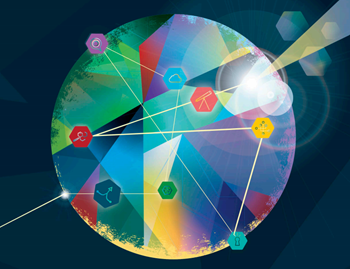There have long been fears that the rise of digital workers, powered by intelligent automation and machine learning, could spell out a bleak future for humans, especially those in roles that could be made redundant by automation.
While there’s some truth to this perception – reskilling and upskilling are an essential part of digital transformation, per Gartner – these fears are largely unfounded, as the most productive course for automation to take is one that prizes combinatorial innovation between humans and their digital counterparts.
Indeed, bringing digital workers into the equation can free employees from the burden of completing labor-intensive, manual tasks—such as data entry or administration—and enable them to focus instead on creating real value in the workplace. As Cliff Justice, partner, U.S. leader, Cognitive Automation and Digital Labor at KPMG says;
Repetitive routines can often drain morale, so intelligent tools like robotic process automation (RPA) can empower employees to engage in activities that are more creative and interactive, such as problem solving or judgement-based tasks.
Deciding where to start
There are vast opportunities to be exploited with this integration, but the pace and scale of the transformations currently underway across all industries make the process challenging and intimidating for many businesses. There are some key elements to clarify when beginning the process of integrating human and digital workers.
First, the vision of any digital transformation strategy must have clear intentions. What benefit does the introduction of a hybrid workforce serve for your business, beyond a broader need to keep pace with the competition? These metrics should be clearly communicated to employees and all external stakeholders so the message is clear: intelligent automation isn’t about downsizing or getting rid of jobs, but about creating value for everyone involved with the organization, from the workforce to the end consumer.
It’s also vital to articulate the skills that will be required from human employees in a new hybrid workforce. This will make it easier for your organization to identify and provide the training, tools and opportunities necessary for this reskilling process. Which tasks can be taken care of with RPA, and what new roles might emerge alongside automated ones?
Ultimately, as CIO reports, enterprise decision makers will need to work to provide a productive integration of human and digital workforces if they’re to successfully reap the potential benefits of digital transformation, which include reduced risk, increased efficiency and lower costs/higher ROI.
As previously highlighted, this isn’t something to consider for the future; the transformation is happening now and it’s happening everywhere, from construction and manufacturing to more obvious sectors like technology.
This is clearly expressed by a McKinsey study from February 2020, which revealed that 87% of surveyed managers and executives reported widening skills gaps. Meanwhile, 75% of respondents to a Gartner survey from April 2020 intend to keep at least 5% of their workforce remote.
Preparing your human workers
The imperative to act, therefore, is an urgent one. Business leaders must build educational solutions to help reskill workers, not just those in tech jobs. Truck drivers, for example, make up a huge part of the workforce in multiple continents and are expected to be among the most impacted employees, as automated vehicles become more prominent. Self-driving trucks are likely to need human assistance for the foreseeable future, so there’s an opportunity for leaders in this space to provide training in transferable skills and move toward a hybrid workforce.
Elsewhere, robotic process automation introduces new platforms that enable organizations to develop and train their existing workforce in new skills, like project management tools and interactive dashboards. Process optimization, then, isn’t about removing humans from operational systems, but about assisting them with existing workflows.
One example is in office logistics. In large workspaces, booking a meeting room or equipment can be a lengthy, frustrating process, involving the exchange of emails and phone calls and walking to and fro to find an empty space. By using machine learning and process automation, in the form of a mobile application, for example, the process of booking and holding a meeting can be simplified.
Since the outset of the pandemic, many workers have undergone this kind of passive digital reskilling, which is bound to help as the world enters into a new normal beyond the virus.
The future is hybrid
Reskilling of human workers is an important aspect of the digital transformation, one that involves the provision of education, training and tools. However, it’s clear that hybrid workforces aren’t just a viable compromise but an essential integration of human and digital workers. If successfully managed, this integration can unlock the full treasure chest of digital transformation benefits, from innovation and workload alleviation to reduced risk and lower costs.
Defining the roadmap to this hybrid workforce and identifying the skills needed for employees within it are the key elements for business leaders to consider. At times, the pace and scale of change can be intimidating, but RPA and other intelligent automation tools are enablers of new and unprecedented value creation. The future isn’t all digital or human but hybrid, and organizations that manage the integration successfully will reap the best of both worlds.
Further reading:
Access the latest business knowledge in IT
Get Access







Comments
Join the conversation...